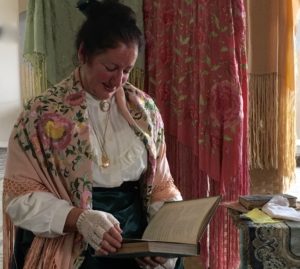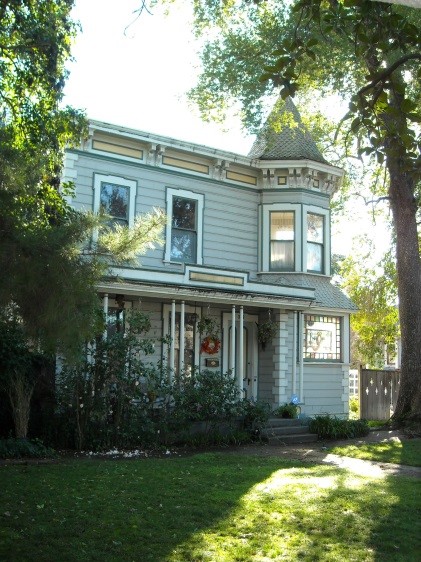Women in history tour highlights homes of Gilroy’s female settlers
Connie Rogers shares city’s rich legacy of ‘women of accomplishment’
Published in the March 20 – April 2, 2019 issue of Gilroy Life

Photo courtesy Phil Laursen
Shay Azevedo gives a dramatic impersonation of Amanda Mae Willson (circa 1910) at the Gilroy Library after a March 2 history walk.
A group led by Connie Rogers of the Gilroy Museum took a walking tour to see the homes of some of Gilroy’s most influential women Saturday, March 2 to kick off Women’s History Month. Under a light pattering of rain, participants viewed three different locations, learning about five women of various backgrounds and eras who made an impact on the city.
Rogers called these ladies “women of accomplishment,” and was eager to share their history. A long-time volunteer at the museum, Rogers started researching where Gilroy’s more notable women had lived. The tour began at the Gilroy Museum, housed in the historic 1910 Carnegie Library Building. Rogers pointed out some of the museum’s displays featuring the women who would be highlighted on the walk, as well as other women whose homes are no longer in existence or would be too far to include in a tour. Afterward, the group embarked on the walking tour, which the Gilroy Historical Society leads monthly. Then the group convened at the Gilroy Library for a dramatic reenactment focused on some of Gilroy’s early residents.
The first stop of the Women’s History Walking Tour was the Willey House, or Willey Cultural Center, across the street from the museum at 140 Fifth St. Though the property is now owned by the city, it once belonged to Judge Howard Willey, a justice of the peace, who bought it in 1893. Willey had two daughters, Grace and Minnie, both of whom enjoyed a talent for music.
 A peek through the front window from the front porch revealed the bay windows Judge Willey installed to accommodate the square grand piano his daughters played. Grace and Minnie were also notable for being self-reliant. They supported themselves with music lessons, which was unusual for women of their era. Both sisters married, although Grace was widowed, and Minnie divorced and later remarried.
A peek through the front window from the front porch revealed the bay windows Judge Willey installed to accommodate the square grand piano his daughters played. Grace and Minnie were also notable for being self-reliant. They supported themselves with music lessons, which was unusual for women of their era. Both sisters married, although Grace was widowed, and Minnie divorced and later remarried.
“They were very independent,” Rogers said, “in that they had their own interests and livelihood.”
The next house was a few blocks west, at 338 Fifth St. The Italianate-style Victorian is known for being the home of two famous Gilroy women. It was built for Caroline Amelia Brooks Osborne Hoxett, and later inhabited by Roberta Hughan.
Caroline Hoxett is the imposing figure staring out of the portrait which hangs over the museum’s mantle. She was born in Ohio and came to California by way of mule, settling in Gilroy in 1868. When Hoxett was widowed in the 1880s, her husband left her a tidy sum of $40,000, quite a fortune in those days. With no children, she decided to “make good use of her money,” according to Rogers. She was active in the Rebekah’s, the women’s auxiliary of the Independent Order of Odd Fellows and now known as Rebekah Children’s Services. She chose the location and donated the land and the money to get things underway. She also donated the lot which once held a tennis court, which was then turned into the Carnegie Library Building (where the museum is now housed), thanks to a $10,000 grant from Andrew Carnegie. Hoxett also donated the clock housed in Old City Hall. Her home was donated to the Gilroy Women’s Civic Club after her death.
In the 1970s, Roberta Hughan bought and restored the home. Hughan became Gilroy’s first female elected council member and the city’s first, and so far its only, female mayor, holding the position from 1983 to 1991.
The tour concluded south of the library, to an area that was once home to Ascencion Solorsano. Though her home is no longer there, it is believed to have stood behind the current property at 7273 Rosanna St. Born in San Juan Bautista in 1836, she was a corondera, or herbal healer, who grew medicinal plants in the backyard of her home. Though she lived a humble life, Solorsano was a community leader. Today, a middle school is named in her honor.
Following the tour, the group took in a dramatization by Shay Azevedo at the Gilroy Library. This unique performance was set in 1910, and featured period costumes, books, and other items of the era. Azevedo captivated the crowd with her skillful storytelling as Amanda Mae Willson. She related the history of San Ysidro, detailing how pioneers seeking to find their fortune in the gold fields had traveled west. She focused on the Willson family and their many pursuits.
Gilroy is home to many historic homes and as time passes, paint fades, vines and trees become overgrown, and properties change hands, Rogers remains interested in sharing her knowledge.
“I learn from these tours and the participants,” Rogers said. Then she quipped, “I’ve only lived here since 1966.”
